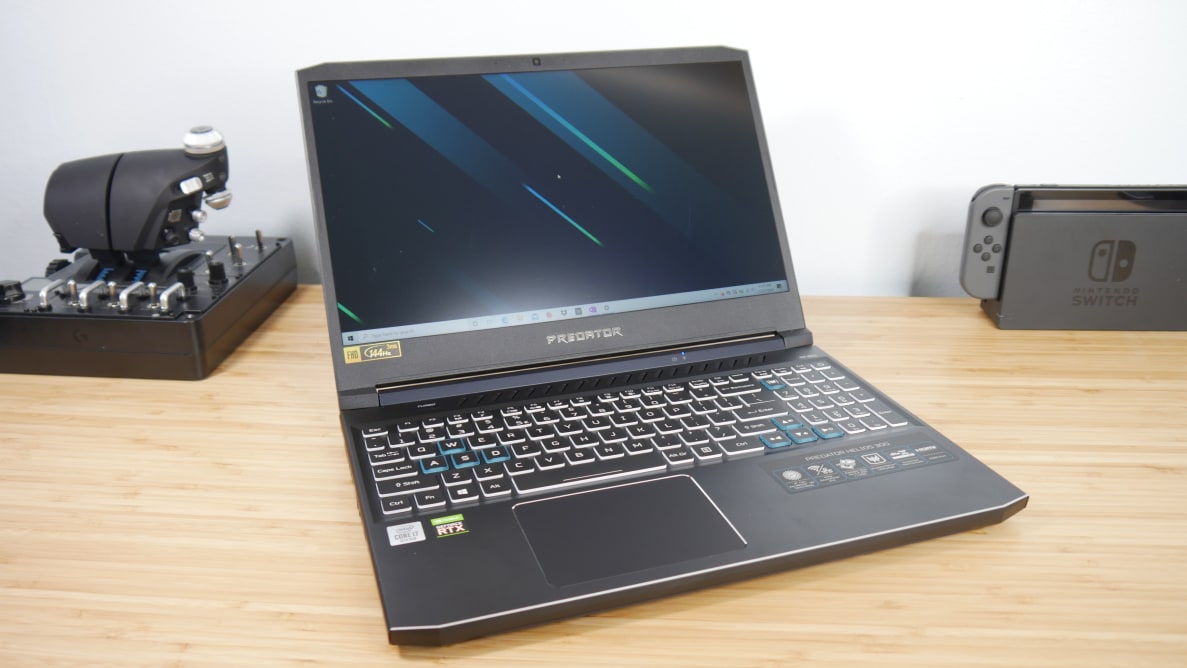Pros
-
Excellent performance
-
Attractive 144 Hz display
-
Pleny of ports
Cons
-
Disappointing keyboard
-
Short battery life
-
Bloatware
About the Acer Predator Helios 300
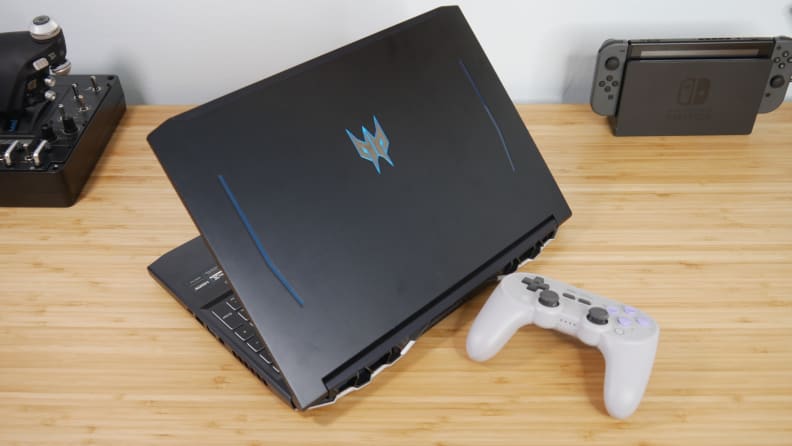
Gaming is what the Helios 300 is built to do, and it excels.
The Predator Helios 300 is the entry-level gaming laptop in Acer’s Predator lineup. It is not, however, the most affordable gaming laptop made by Acer, as the company’s most affordable gaming hardware is sold under the Nitro brand. Still, the Predator Helios 300 packs impressive specifications for its price:
- Processor: 10th Generation Intel Core i7-10750H 6-Core processor 2.6 GHz with Turbo Boost Technology up to 5 GHz
- Memory: 16 GB DDR4 2933MHz dual-channel
- Storage: 512 GB PCIe NVMe SSD (2x PCIe M.2 Slots, one slot available), one available hard drive bay
- Graphics: Overclockable NVIDIA GeForce RTX 2060 with 6 GB of dedicated GDDR6 VRAM
- Display: 15.6" Full HD (1920 x 1080) widescreen LED-backlit IPS display, 144 Hz refresh rate
- Battery: 58 watt-hour 4-cell lithium-ion
- Ports: 1x USB Type-C port supporting USB 3.2 Gen 2 (up to 10 Gbps) & charging, 1x USB 3.2 Gen 2 Port (with power-off charging), 2x USB 3.2 Gen 1 Ports, 1x HDMI 2.0 port with HDCP Support, 1x Mini-DisplayPort 1.4
- WiFi: Killer Double Shot Pro Wireless-AX 1650i 802.11ax WiFi 6 featuring 2x2 MU-MIMO technology (Dual-Band 2.4 GHz and 5 GHz)
- Dimensions: 14.2” wide, 10” deep, 0.9” thick
- Weight: 5.51 pounds
The configuration we tested is the most basic Helios 300 available. Acer offers several alternative configurations with more RAM, storage, or more powerful Nvidia RTX 2070 graphics. There’s even a 17-inch model available in several configurations, though it’s more difficult to find at retailers.
Be warned that older models of the Helios 300 are still available. These have a ninth-generation Intel processor and may have Nvidia GeForce GTX 1660 Ti graphics. There’s nothing wrong with older models, but we noticed many retailers are charging nearly as much for the old model as the new one.
What we like
Game performance is outstanding
A gaming laptop is, of course, built to game. Performance is an absolute necessity. Fortunately for Acer, the Predator Helios 300 is a shockingly athletic laptop.
We tested the laptop in our usual gaming benchmark suite, which includes 3DMark, Metro Exodus, and Shadow of the Tomb Raider. We also played a wide selection of games, from Godfall to World of Warcraft. The Helios 300 consistently performed above expectations and, in benchmarks, defeated other laptops with Nvidia RTX 2060 graphics hardware, like Asus’ ROG Zephyrus G14.
It does have limits. Godfall, a next-gen game that can challenge even beefy desktops, came just short of a stable 60 frames per second at medium detail. You’ll have to turn down detail settings in the most demanding PC games.
Still, the Helios 300 is exceptionally quick for an affordable gaming laptop, offering outstanding value. You can’t expect more for $1,199.
The laptop’s processor performance is strong, too. Our test unit, like most Helios 300 configurations, has an Intel Core i7-10750H six-core processor. It hit benchmark scores that fell just short of more expensive laptops with the better Intel Core i7-10875H, like the Razer Blade 15. The Helios 300 even defeated Dell’s XPS 15 with Intel Core i9-9980HK in the Cinebench R20 benchmark, and nipped at the Dell’s heels in other tests.
Asus’ ROG Zephyrus G14 beat the Helios 300 in multi-core processor tests, however, thanks to its AMD Ryzen 9-4900HS processor. AMD’s Ryzen processors are preferable if you plan on heavy, multi-core workloads like professional video or photo editing.
The display is butter-smooth
Affordable laptops have a reputation for poor display quality that was well deserved even a few years ago. Laptops like the Acer Predator Helios 300 have made those concerns a thing of the past. The Helios 300 has a pleasant 1080p display with a 144 Hz refresh rate. Put simply, it updates the display up to 144 times per second, while most laptop screens only update 60 times per second.
The refresh rate is a highlight. We didn’t see a benefit in demanding games, like Godfall and Metro Exodus, as the Helios 300 isn’t powerful enough to run those titles beyond 60 FPS. But we did notice a difference in less demanding titles like Diablo III and Final Fantasy XIV. Intense fights with flashy effects benefited from the display’s strong motion clarity. These games felt more responsive than usual, as well. The only downside is the competition, which almost universally offers the same technology. 144 Hz is now standard on gaming laptops.
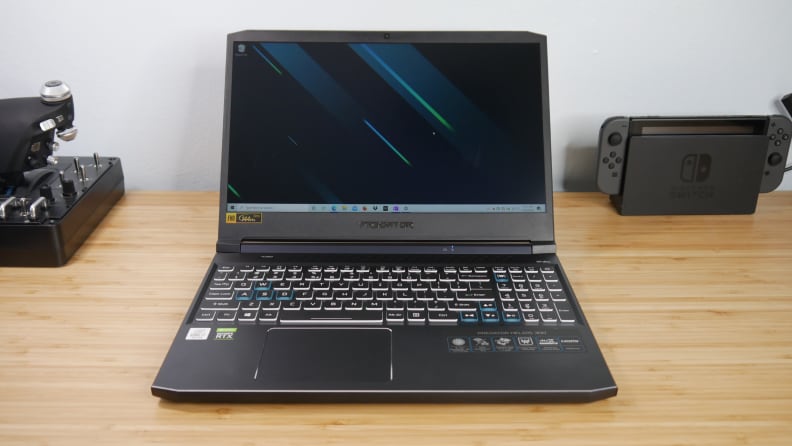
The Helios 300 has a basic, inoffensive design.
Image quality is also respectable. The Helios 300’s display isn’t exceptionally bright, colorful, or sharp, but it’s more than adequate, and games look vibrant and compelling. Like all laptops in this price range, the Helios 300 uses IPS display technology. This result is excellent viewing angles, an important trait for a laptop, which is more likely to be used at odd angles than a desktop monitor. IPS technology suffers from poor contrast, however, which can make dark scenes look dull and gray.
While the screen’s maximum brightness is modest, the laptop benefits from an anti-glare finish that makes reflections less of an issue. The display is usable in almost any indoor lighting and gamers playing in a dim room will want to bump its brightness several notches down from the maximum setting.
Overall, the Helios 300’s display is attractive in most situations and smooth in motion. You can pay much, much more for a gaming laptop and not see much improvement in the display.
There are plenty of ports
Expensive laptops offer more features than affordable models, but connectivity can be the exception. Here, the Acer Predator Helios 300 scores a clear win.
Starting with USB, the Helios 300 offers three USB 3.2 Type-A ports and one USB 3.2 Type-C port. The Type-C port doesn’t support DisplayPort so, unfortunately, this laptop can’t provide a one-cable connection to a USB-C monitor. Still, you have plenty of options for connecting USB devices.
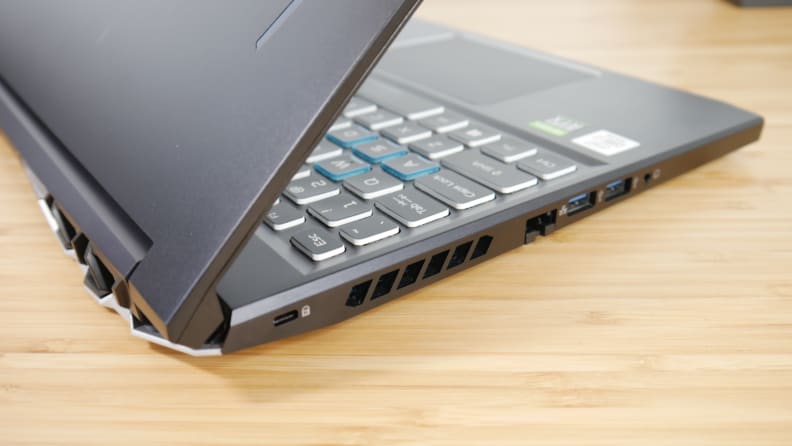
The Helios 300 doesn't skimp on ports.
External video is delivered through a full-sized HDMI 2.0 port, or a Mini-DisplayPort 1.4 port. We used the HDMI port extensively, pairing the laptop with an Nvidia G-Sync compatible monitor, and experienced no issues. A combined 3.5mm headphone/microphone jack and Ethernet round out the options.
Wireless connectivity is solid. The Helios 300 supports WiFi 6 and Bluetooth 5.0. We were impressed by its WiFi speeds, which hit over 700 Mbps in benchmarks. Real-world downloads from Epic and Steam fluctuated between 40 and 60 megabytes per second.
What we don't like
The keyboard fights back
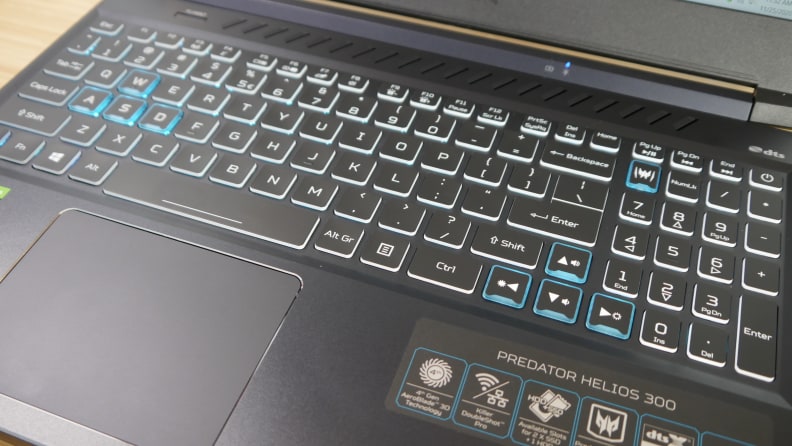
The Helios 300's keyboard is its only significant flaw.
A good keyboard is an important part of any laptop, no matter its intended use. Unfortunately, the Acer Predator Helios 300 settles for a keyboard that's best described as usable. Its main issue is key feel. The Helios 300 is burdened by mushy keys that don’t communicate well with your fingerprints. This led to frequent missed keys while typing quickly on the laptop.
The Shift key is a sticking point. It often felt fully depressed yet didn’t register, which forced us to slow down our typing and hit keys with more force. Even then, we found extra typos caused by missed letters or incorrect capitalization.
It’s not all bad. The keyboard has an airy layout with plenty of space between keys and gobs of space for resting your palms. A numpad is included and, though it does slim down the size of each key, it’s still large enough to feel comfortable. The sizable touchpad is solid for a gaming laptop, with plenty of space and a snappy, responsive feel.
Keyboard backlighting is standard. It’s only offered in blue, but it’s bright and effective. The laptop also includes full-sized arrow keys, which can be useful in games.
Small battery + gaming = poor battery life
Acer ships the Predator Helios 300 with a small 4-cell, 58 watt-hour battery. We’ve tested 13-inch laptops with more juice on tap. Predictably, this is bad news for battery life.
We saw a maximum of three hours of endurance, and a minimum of one and a half hours, during real-world tests. Our best results were achieved writing this review which, of course, meant spending time in Microsoft Word. The worst result came while using the laptop for video calls.
In our benchmark, which loops web pages to simulate normal web browsing, the Helios 300 hit two hours and 24 minutes of endurance. That's easily among the worst results we've recorded, well behind the Asus ROG Zephyrus G14 and Razer Blade 15. However, the Predator Helios 300 did beat MSI's GE75 Raider.
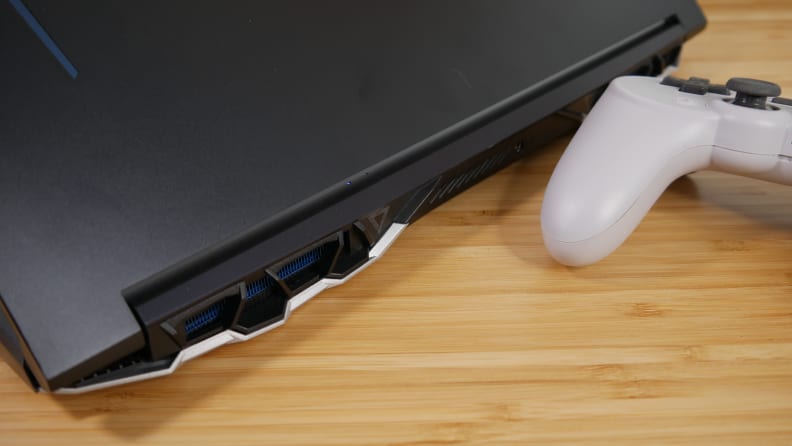
Large vents help keep the Helios 300 cool.
The Acer's battery life is much worse than average for a laptop, but only below average for the gaming laptop category. Affordable gaming laptops always cut back on battery size to keep costs low. This limitation will frustrate some owners, but it’s a compromise gamers on a budget are forced to accept. The only solution is to spend more on a gaming laptop with a larger battery.
Revenge of the bloatware
Bloatware isn’t as common on modern laptops as those sold a decade ago, but the Acer Predator Helios 300 is proof it can still be a problem.
Our test unit arrived with Norton Security Ultra, Dropbox, Firefox, and GoTrust ID installed. It also came with an app called Acer Collection 5, which is little more than an ad encouraging you to download additional apps like Netflix and Facebook from the Microsoft Store.
The Norton, Dropbox, and Firefox installations prompted us to install software or renew a subscription at least once during our testing. Norton, unsurprisingly, was the most aggressive, launching an annoying pop-up daily. Luckily, you can uninstall all the offending apps through the usual uninstall process.
Should you buy it?
Yes. The Acer Predator Helios 300 isn’t perfect, but few laptops can match its value.
This laptop is popular for good reason. Starting at $1,199 (or less on sale), the Helios 300 delivers a powerful six-core Intel processor and an Nvidia RTX 2060 GPU that’s a good match for the laptop’s 1080p 144 Hz display.
Most of our complaints are standard traits of affordable gaming laptops. The Helios 300 is large, heavy, and suffers poor battery life, but its performance in these areas is no worse than its competition. And despite its value, the Helios 300 is a sturdy laptop with a conservative design that is unlikely to offend.
The keyboard is its one true flaw. Mushy, imprecise key feel makes the Helios 300 less pleasant to use for day-to-day productivity.
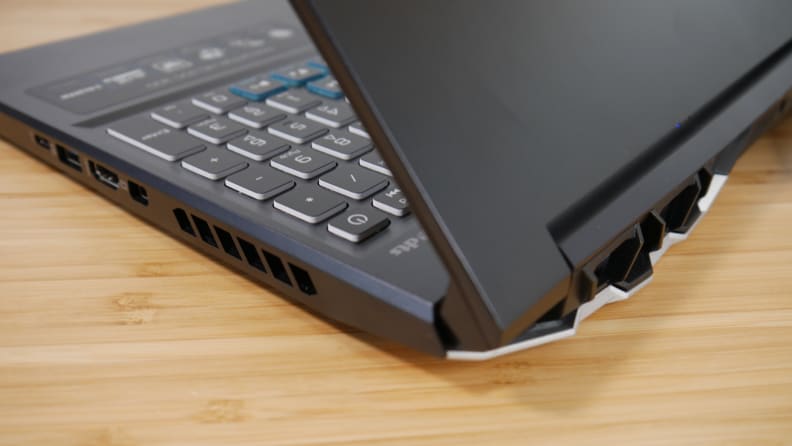
The Helios 300's large vents dominate the laptop's rear.
What’s the competition? Acer has an even more affordable option with its Acer Nitro 5. It can be purchased with similar hardware for $999, though it does have an older Intel processor and a tiny 256 GB hard drive. The Helios 300 is a better value overall.
Dell’s Inspiron G5 15 is a solid alternative. Though sold at a higher MSRP of $1,439, Dell frequently discounts the laptop to $1,199. It looks more attractive, has a better keyboard, and includes a larger battery.
While Asus’ G14 is a standout in design, its more expensive than the Helios 300 when similarly equipped. The Asus’ TUF 506IV is a more direct competitor, but we’ve yet to test that model.
The Helios 300 excels in game performance, and that’s what counts. It’s an excellent value at $1,199 and a safe pick for players on a budget.
Meet the tester
Matthew S. Smith is a veteran tech journalist and general-purpose PC hardware nerd. Formerly the Lead Editor of Reviews at Digital Trends, he has over a decade of experience covering PC hardware. Matt often flies the virtual skies in Microsoft Flight Simulator and is on a quest to grow the perfect heirloom tomato.
Checking our work.
Our team is here to help you buy the best stuff and love what you own. Our writers, editors, and experts obsess over the products we cover to make sure you're confident and satisfied. Have a different opinion about something we recommend? Email us and we'll compare notes.
Shoot us an email